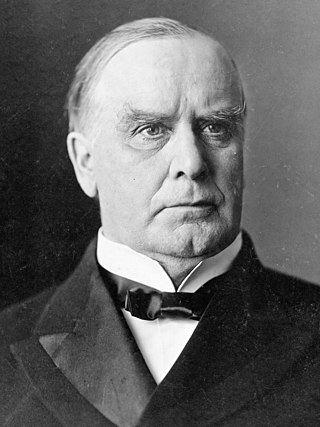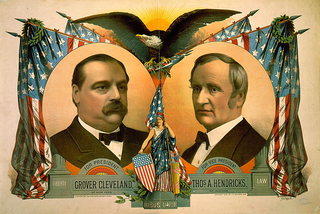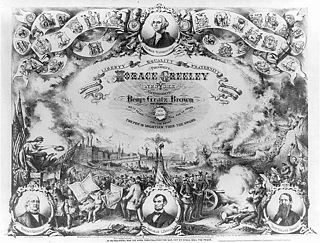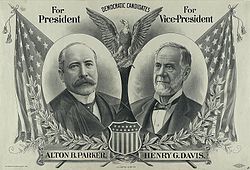
The 1900 United States presidential election was the 29th quadrennial presidential election, held on Tuesday, November 6, 1900. In a re-match of the 1896 race, incumbent Republican President William McKinley defeated his Democratic challenger, William Jennings Bryan. McKinley's victory made him the first president to win a consecutive re-election since Ulysses S. Grant accomplished the same feat in 1872. Until 1956, this would be the last time in which an incumbent Republican president would win re-election after serving a full term in office. This election saw the fifth rematch in presidential history, something that would also not occur again until 1956. This was also the first rematch to produce the same winner both times.

The 1904 United States presidential election was the 30th quadrennial presidential election, held on Tuesday, November 8, 1904. Incumbent Republican President Theodore Roosevelt defeated the conservative Democratic nominee, Alton B. Parker. Roosevelt's victory made him the first president who ascended to the presidency upon the death of his predecessor to win a full term in his own right. This was also the second presidential election in which both major party candidates were registered in the same home state; the others have been in 1860, 1920, 1940, 1944, and 2016.

The 1908 United States presidential election was the 31st quadrennial presidential election, held on Tuesday, November 3, 1908. Republican Party nominee William Howard Taft defeated three-time Democratic nominee William Jennings Bryan.

William Jennings Bryan was an American lawyer, orator, and politician. Beginning in 1896, he emerged as a dominant force in the Democratic Party, running three times as the party's nominee for President of the United States in the 1896, 1900, and 1908 elections. He served in the House of Representatives from 1891 to 1895 and as the Secretary of State under Woodrow Wilson from 1913 to 1915. Because of his faith in the wisdom of the common people, Bryan was often called "the Great Commoner", and because of his rhetorical power and early fame as the youngest presidential candidate, "the Boy Orator".

Alton Brooks Parker was an American judge. He was the Democratic nominee in the 1904 United States presidential election, losing in a landslide to incumbent Republican Theodore Roosevelt.

Bourbon Democrat was a term used in the United States in the later 19th century and early 20th century (1872–1904) to refer to members of the Democratic Party who were ideologically aligned with fiscal conservatism or classical liberalism, especially those who supported presidential candidates Charles O'Conor in 1872, Samuel J. Tilden in 1876, President Grover Cleveland in 1884, 1888, and 1892 and Alton B. Parker in 1904.

The 1904 Democratic National Convention was an American presidential nominating convention that ran from July 6 through 10 in the Coliseum of the St. Louis Exposition and Music Hall in St. Louis, Missouri. Breaking with eight years of control by the Democratic Party's reform wing, the convention nominated conservative Judge Alton B. Parker of New York for president and Henry G. Davis of West Virginia for vice president.

After losing re-election to Republican Benjamin Harrison in 1888 and leaving office in 1889, U.S. President Grover Cleveland was initially satisfied with his return to private life. However, Cleveland's views about his retirement began to change at the time of the 1890 midterm elections, in which the Democrats won huge victories at the ballot box. In addition, Cleveland disliked what he perceived to be the frequent blunders of the Harrison administration. By the time 1891 ended, Grover Cleveland decided to re-enter American political life and run again for U.S. president in the 1892 U.S. presidential election.

President of the United States Grover Cleveland's first term (1885-1889) was most notable "for its record number of vetoes (414), more than double the number issued by all his predecessors combined." During Cleveland's first term, controlling Congressional and "wasteful spending" was an important priority for him and his administration. Cleveland's vetoes angered the Grand Army of the Republic (GAR), a powerful organization advocating for Union veterans. In his State of the Union Address in December 1887, President Cleveland called for lower tariffs and tariff reform, making it a major issue in the upcoming 1888 U.S. Presidential election.

The 1904 United States elections elected the members of the 59th United States Congress. It occurred during the Fourth Party System. Republicans maintained control of the presidency and both houses of Congress. For the first time since the 1828 election, no third party or independent won a seat in Congress.

The 1908 United States presidential election in Utah was held on November 3, 1908, throughout all forty-six contemporary states as part of the 1908 United States presidential election. State voters chose three representatives, or electors to the Electoral College, who voted for president and vice president. This was the last election when Utah had the minimum three electoral votes as it would gain a second congressional district after the 1910 Census.

The 1884 presidential election was the first nationwide campaign in which Grover Cleveland participated and the first of two in which he emerged victorious. This election pitted Democratic Party nominee Cleveland against Republican party nominee James G. Blaine and the campaign centered on corruption, civil service reforms, and political scandals. In this election, Cleveland portrayed himself as the clean and honest candidate in contrast to Blaine, who was portrayed as corrupt.

After serving one term as U.S. President, Rutherford B. Hayes announced that he would not seek re-election in 1880. Thus, the 1880 election ended up being fought between Republican James A. Garfield, the winner, and Democrat Winfield Scott Hancock.

The 1876 U.S. presidential election occurred at the twilight of Reconstruction and was between Republican Rutherford B. Hayes and Democrat Samuel J. Tilden. After an extremely heated election dispute, a compromise was eventually reached where Hayes would become U.S. President in exchange for the end of Reconstruction and a withdrawal of U.S. federal troops from the South.

The 1900 United States presidential election took place after an economic recovery from the Panic of 1893 as well as after the Spanish–American War, with the economy, foreign policy, and imperialism being the main issues of the campaign. Ultimately, the incumbent U.S. President William McKinley ended up defeating the anti-imperialist William Jennings Bryan and thus won a second four-year term in office.

In 1872, Horace Greeley ran unsuccessfully for President of the United States. He served as the candidate of both the Democrats and the Liberal Republicans, in the 1872 election. In the run-up to the 1872 United States presidential election, major changes occurred in the United States. Specifically, the 15th Amendment gave African-Americans the right to vote for the first time, while the government cracked down on the Ku Klux Klan. In addition, the economy was still in good shape and President Ulysses S. Grant's corruption scandals for the most part were still not public knowledge. With this background, the incumbent U.S. President was able to decisively defeat Greeley.

The 1908 U.S. Presidential election occurred in the backdrop of the Progressive achievements of U.S. President Theodore Roosevelt's second term as well as against the U.S. recovery following the Panic of 1907. In this election, Roosevelt's chosen successor, Republican William Howard Taft, ran in large part on Roosevelt's Progressive legacy and decisively defeated former Congressman and three-time Democratic U.S. Presidential candidate William Jennings Bryan. Overall, the 1908 presidential campaign and election were about labor issues, trusts, campaign finance reform, imperialism, and corruption.

The 1908 United States presidential election in Maryland took place on November 3, 1908. All contemporary 46 states were part of the 1908 United States presidential election. State voters chose eight electors to the Electoral College, which selected the president and vice president.

In 1868, the Democrats nominated former New York Governor Horatio Seymour for President and Francis Preston Blair Jr. for Vice President. The Seymour-Blair ticket ran on a platform which supported national reconciliation and states' rights, opposed Reconstruction, and opposed both Black equality and Black suffrage. Meanwhile, the Republican presidential ticket led by General Ulysses S. Grant benefited from Grant's status as a war hero and ran on a pro-Reconstruction platform. Ultimately, the Seymour-Blair ticket ended up losing to the Republican ticket of General Ulysses S. Grant and House Speaker Schuyler Colfax in the 1868 U.S. presidential election.




















